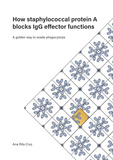How staphylococcal protein A blocks IgG effector functions
A golden way to evade phagocytosis

Queiroz da Cruz, Ana Rita
- Promoter:
- Prof.dr J.A.G. (Jos) van Strijp & prof.dr S.H.M. (Suzan) Rooijakkers
- Research group:
- Rooijakkers , Strijp
- Date:
- January 13, 2022
- Time:
- 14:15 h
Summary
In this thesis we investigate the molecular mechanisms whereby staphylococcal protein A produced by S. aureus blocks IgG-mediated phagocytosis. Although SpA was the first antiphagocytic molecule of S. aureus to be described, it still remains unclear how SpA can inhibit IgG effector functions by binding to IgG-Fc region. Because the anti-phagocytic properties of SpA likely represent one of the main contributing factors for the poor efficacy of the antibody dependent immune response against S. aureus, knowledge about these mechanisms may help to gain insight for the development of successful anti-S. aureus therapies. Next to understanding the mechanisms of immune escape, it is also important to know when immune evasion and other virulence factors are produced during infection. Because S. aureus is the main cause of human skin and soft tissue infections, we also assess the gene expression profile of S. aureus virulence factors, including SpA, in the context of human skin infections. Insights about the S. aureus gene expression within the target tissue may be required for the design of anti-S. aureus therapeutic strategies.